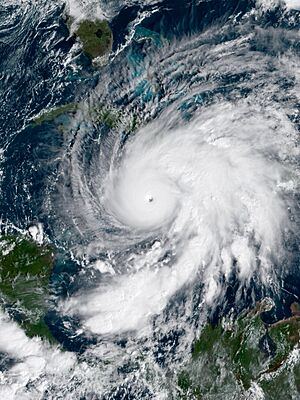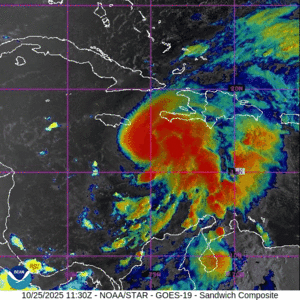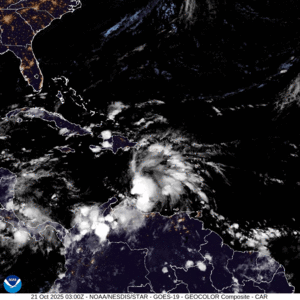Hurricane Melissa facts for kids

Melissa at peak intensity shortly before landfall in Jamaica on October 28
|
|
| Meteorological history | |
|---|---|
| Formed | October 21, 2025 |
| Extratropical | October 31, 2025 |
| Category 5 tropical cyclone | |
| 1-minute sustained (SSHWS/NWS) | |
| Highest winds | 185 mph (295 km/h) |
| Lowest pressure | 892 mbar (hPa); 26.34 inHg (One of the lowest pressures ever recorded in the Atlantic Ocean) |
| Overall effects | |
| Fatalities | 67+ |
| Injuries | 45+ |
| Missing | 21+ |
| Damage | Unknown |
| Areas affected |
|
|
Part of the 2025 Atlantic hurricane season |
|
Hurricane Melissa was a super strong and damaging storm that hit Jamaica and Cuba in October 2025. It was the thirteenth named storm and the third Category 5 hurricane of the 2025 Atlantic hurricane season. Melissa was the strongest tropical cyclone in the world in 2025. It was also one of the most powerful Atlantic hurricanes ever recorded, especially when it hit land.
Melissa started as a tropical wave from West Africa on October 16. It traveled across the Atlantic Ocean and into the Caribbean Sea. On October 21, it grew into Tropical Storm Melissa. For a few days, Melissa moved slowly and didn't get much stronger.
But from October 25 to 27, it quickly became a Category 5 hurricane. Melissa hit New Hope, Jamaica, on October 28, at its strongest point. Later that day, it moved off Jamaica's coast and then hit Chivirico, Cuba, on October 29.
After hitting land twice, Melissa became weaker. It passed near Bermuda as a Category 2 hurricane before changing into a different type of storm on October 31. Sadly, at least 67 people lost their lives because of Melissa. This was mostly due to floods and landslides in Haiti and Jamaica. The total cost of the damage is still being figured out.
Contents
Understanding Hurricane Melissa
How Melissa Formed and Grew
On October 16, 2025, weather experts started watching a tropical wave moving west. This wave had the potential to grow into a storm. By October 19, it had moved through the Windward Islands and into the Caribbean Sea.
The disturbance moved quickly at first, then slowed down. This gave it a chance to organize and develop. On October 21, it officially became Tropical Storm Melissa. For a few days, Melissa moved slowly and didn't get much stronger. This was because of weak steering currents and something called wind shear. Wind shear is when winds blow at different speeds or directions at different heights. This can stop a storm from getting stronger.
But on October 23, the wind shear weakened. This allowed Melissa to become more organized and start strengthening.
Melissa's Journey Across the Caribbean
Melissa then entered very good conditions for growth. It went through a period of rapid intensification on October 25. Its winds quickly increased from 70 mph (110 km/h) to 140 mph (225 km/h) in just 18 hours!
After a short break, Melissa continued to get stronger. By October 27, it became a powerful Category 5 hurricane. The next morning, it reached its strongest point. Its winds were about 160 mph (260 km/h). Its central pressure dropped to 892 mbar. This was about 45 miles (70 km) south-southeast of Negril, Jamaica.
At 1:00 PM UTC on October 28, Melissa hit land near New Hope in Westmoreland Parish, Jamaica. It was at its peak strength. As it moved over Jamaica's mountains, it weakened. It then moved off Jamaica's north coast as a Category 4 storm, heading towards Cuba. It weakened further to a Category 3 hurricane.
Melissa briefly strengthened back to a Category 4. It then made landfall in eastern Cuba on October 29. Its winds were about 120 mph (195 km/h). This was near Chivirico. Cuba's rugged mountains caused Melissa to weaken again. It became a Category 2 storm as it moved back into the Atlantic Ocean.
The storm then weakened to a Category 1. It started moving faster towards the northeast. It passed near Long Island in The Bahamas. Later that day, it strengthened again to a Category 2. It had winds of 90 knots (105 mph, 170 km/h) as it headed towards Bermuda.
On October 31, Melissa began to change. It was moving into an area with more wind shear and cooler ocean waters. It weakened to a Category 1 storm as it passed near Bermuda. On the same day, Melissa finished changing into a hurricane-force extratropical cyclone. This is a different type of storm that gets its energy from temperature differences, not warm ocean waters.
Amazing Records Set by Melissa
Melissa set several impressive records:
- It was the strongest tropical cyclone in the world in 2025.
- It had the highest wind gust ever measured by a special tool called a dropsonde. This gust was 252 mph (406 km/h)!
- Melissa was one of the most intense Atlantic hurricanes ever recorded. This is based on its very low central pressure. It was tied with the 1935 Labor Day hurricane for third place.
- It was also one of the strongest Atlantic hurricanes to hit land. It was tied with the 1935 Labor Day hurricane and Hurricane Dorian.
- Melissa was the strongest tropical cyclone ever to make landfall in Jamaica.
- Unlike many very strong hurricanes, Melissa did not go through an "eyewall replacement cycle." This helped it stay super strong for a longer time.
Getting Ready for the Storm
Caribbean Islands Prepare
People across the Caribbean islands took many steps to prepare for Hurricane Melissa. On October 21, a hurricane watch was issued for parts of Haiti. A tropical storm watch was issued for Jamaica. These warnings were upgraded as the storm got closer.
Cruise ships like the Margaritaville at Sea Islander and Disney Treasure changed their routes. This was to avoid the storm. Airlines cancelled 167 flights in the Caribbean. This affected airports in the Bahamas, Barbados, Haiti, Jamaica, and the US Virgin Islands.
Jamaica's Preparations
In Jamaica, the Ministry of Transportation used 30 buses for emergencies. The National Water Commission made sure over 548,000 people had access to clean drinking water. The University of the West Indies asked students to evacuate. Graduation ceremonies were postponed.
Public places like the National Gallery of Jamaica and the Bob Marley Museum closed on October 24. All airports were shut down on October 25. Bus services were also stopped.
Cuba's Evacuations
In Cuba, President Miguel Díaz-Canel announced that 735,000 people were evacuated. These evacuations happened in the eastern parts of the country. The United States Navy also moved hundreds of people from Guantanamo Bay Naval Base to Florida.
Other Areas Get Ready
In Puerto Rico, flood warnings were issued on October 22. This was due to heavy rains from Melissa's outer bands. The Dominican Republic opened shelters. Twelve provinces were put on red alert. About 90 people left Saona Island.
The Government of the Cayman Islands gave out sandbags. Cayman Airways allowed people to change flights without extra fees. Diving activities stopped on Little Cayman and Cayman Brac.
Trinidad and Tobago and Martinique issued weather alerts. Schools in Curaçao closed to help emergency services. Colombia warned about rough seas along its coast.
In The Bahamas, hurricane warnings were issued for central and southwest islands. People were told to evacuate from several islands. The British Ministry of Defence sent aid to the Turks and Caicos Islands.
Bermuda also had a hurricane warning. The Causeway, buses, and L.F. Wade International Airport closed on October 30. They reopened on October 31. A shelter was opened at Cedarbridge Academy.
Melissa's Impact on Land
| Country | Deaths | Injuries | Missing |
|---|---|---|---|
| Cuba |
|
|
|
| Dominican Republic |
|
|
|
| Haiti |
|
|
|
| Jamaica |
|
|
Unknown |
| Total | 67 | 45 | 21 |
Effects in the Caribbean
Melissa caused significant damage and disruption across the Caribbean.
Damage in Haiti and Dominican Republic
In Haiti, 30 people lost their lives. Flooding and landslides caused much of this. At least 450 homes were damaged across the country.
In the Dominican Republic, over 1.1 million people lost access to water. This was because heavy rainfall and flooding damaged water systems. Roads were damaged, and a hospital in Constanza had to close. Four people died in the country.
Jamaica Faces the Storm
Before Melissa hit Jamaica, three people died in accidents while preparing for the storm. Flooding was reported in Old Harbour. Many communities lost power. About 530,000 homes and businesses lost electricity after Melissa struck. Communication was lost in several parishes that were hit hardest.
Hurricane Melissa made landfall in New Hope, Westmoreland, as a very powerful Category 5 hurricane. There was widespread damage in Saint Elizabeth. Many houses were submerged in water. The town of Mandeville experienced severe flooding. The hospital in Black River had its roof blown off. Nearly 90% of homes in Black River lost their roofs.
Much of Montego Bay was flooded, including the airport terminal. Falmouth also saw widespread damage to buildings and trees. In Kingston, a billboard frame fell, and a road was blocked by a landslide.
Sadly, at least 31 people died across Jamaica. The full extent of the damage and loss of life was hard to know at first. This was because communication and access to remote areas were difficult.
Cuba's Experience
Before Melissa hit Cuba, it caused flooding and landslides in Santiago de Cuba. When Melissa made landfall, President Miguel Díaz-Canel reported "considerable damage." There was widespread flooding and debris in Santiago de Cuba.
About 992,000 houses were damaged or destroyed in several provinces. Two people died when the Sagua River overflowed. The Cauto River also overflowed, with some areas getting around 20 inches of rain. Holguín lost power and cell service.
At the U.S. Guantanamo Bay Naval Base, 16 homes were damaged. The air traffic control tower was also partly flooded.
Impact Beyond the Caribbean
Melissa caused rough seas along the Colombian coast. Waves reached up to 3.5 meters (11 feet).
As Melissa passed through the Bahamas, it brought strong winds. Winds reached 85 mph (137 km/h) on Crooked Island. Power outages were widespread. Trees were uprooted, and roofs were damaged. Deadman's Cay Airport was flooded. Many roads were blocked by debris.
In Bermuda, L.F. Wade International Airport recorded wind gusts up to 61 mph (98 km/h). About 19,000 customers lost power.
In New York, Melissa's moisture caused heavy rainfall. This set a new daily rainfall record in Central Park. Two people died due to basement flooding caused by this rain.
Helping Hands After the Storm
Many groups and organizations quickly offered help after Hurricane Melissa. The Miami Heat basketball team and its partners donated about US$1 million in supplies to Jamaica. Other aid groups in South Florida also helped affected islands.
The Walt Disney Company gave US$1 million to relief efforts. American Airlines raised over US$1.2 million for the American Red Cross. The Philadelphia Union soccer team, with player Andre Blake, organized a relief drive for Jamaica.
The World Bank worked with the Jamaican government to assess the damage. The government of the Cayman Islands sent US$200,000 in supplies and promised US$1.2 million in aid to Jamaica. BermudAir helped with airlifts to Jamaica.
The government of Trinidad and Tobago sent eight containers of supplies. Home Depot co-founder Arthur Blank donated US$1.5 million to World Central Kitchen for food and water. He also gave US$1 million to Team Rubicon for on-the-ground help. The United States Department of State sent a disaster assistance team to help with search and recovery.
See also
 In Spanish: Huracán Melissa para niños
In Spanish: Huracán Melissa para niños
- Weather of 2025
- Tropical cyclones in 2025
- List of Category 5 Atlantic hurricanes
- Hurricanes in Hispaniola
- List of Jamaica hurricanes
- List of Cuba hurricanes



